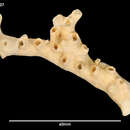en
names in breadcrumbs


“38. Enallopsammia rostrata (Pourtalès, 1878)
Plate 18, figs. 1-4
Amphihelia rostrata Pourtalès, 1878, p. 204, pl. 1, figs. 4, 5.
Stereopsammia rostrata; Pourtalès, 1880, pp. 97, 110, 111.
Dendrophyllia (Coenopsammia) amphelioides Alcock, 1902, pp. 42, 43, pl. 5, figs. 37, 37a.—Not D. (C.) amphelioides; Gardiner and Waugh, 1939, p. 238.
Amphihelia adminicularis Rehberg, 1892, p. 10, pl. 4, fig. 1.
Anisopsammia rostrata; von Marenzeller, 1904a, pp. 314, 315, pl. 18, fig. 23.—Gravier, 1920, pp. 102-104, pl. 12, figs. 181-185.
Anisopsammia amphelioides; Vaughan, 1907, pp. 156, 157, pl. 47, figs. 1, 2.
Dendrophyllia amphelioides var. cucullata Vaughan, 1907, p. 157, pl. 47, fig. 3, pl. 48, figs. 1-4.
Madrepora ramea; Gardiner and Waugh, 1939, pp. 226, 227.
Dendrophyllia minuscula; Gardiner and Waugh, 1939, p. 237 (part).
Enallopsammia rostrata; Squires, 1959, p. 40.—Laborel, 1970, p. 156.—Zibrowius, 1973, pp. 44, 45, pl. 2, figs. 14, 15; 1980, pp. 201-203, pl. 105, figs. A-K, pl. 106, figs. A-C.—Cairns, 1979, pp. 186-188, pl. 37, figs. 2, 3, 6.
Enallopsammia amphelioides; Zibrowius, 1973, pp. 45-48, pl. 3, figs. 16-20; 1980, pp. 203, 204, pl. 106, figs. D-I.
Description. Colony flabellate, dendroid; extra tentacular branching occurring at every or every second or third corallite. Base of colony massive, up to 3 cm in diameter. Calices 3-5 mm in diameter, round to teardrop shaped, occurring on only one side of colony. Calices projecting upward costoseptal rostrum, formed by enlargement of one CS1 and sometimes adjacent septa. Rostrum variable in development and sometimes absent. Both sides of branches costate, coenosteum solid. Septa hexamerally arranged in three cycles, rarely with additional S4. S1 largest septa, septa of other two cycles progressively smaller; S3 some times fused to S2 halfway to columella. Septa not exsert except for S1 forming rostrum. Inner edges of septa variable, from smooth to laciniate, sometimes bearing wide paliform lobes. All septa narrow, thick near calice and thinner toward columella, and bearing spiny granules. Columella rudimentary, spongy.
Discussion. More complete descriptions, additional illustrations, and an explanation of the synonymy can be found in works by Zibrowius [1973, 1980] and Cairns [1979].
According to Zibrowius [1973] the main difference between E. rostrata and E. amphelioides is the degree of development of the exsert S1, or rostrum: the former has a prominent rostrum, whereas the latter has a reduced rostrum or none at all. After reexamination of Atlantic specimens previously reported [Cairns, 1979] and additional specimens from the eastern Atlantic, off Hawaii, and off New Zealand, I am led to agree with Vaughan [1907] that there is a continuous intergradations between the extreme rostrate and nonrostrate forms, not only off Hawaii but also in the western Atlantic and off New Zealand. In fact, a single branch from an Albatross station 3827 specimen bears extremely rostrate calices, nonrostrate calices, and some that are intermediate in development with only a slightly developed S1. The development of the rostrum seems to be influenced by microenvironmental changes and may be a reaction to a poor feeding area. The most extreme rostra are often those of calices which are adjacent to other corals or in close proximity to other corallites of the same colony. I agree with Vaughan [1907] that these differences should be designated as varietal or formae, not as separate species. It may be useful to refer to all specimens with a rostrum, or enlarged S1, as the typical form and to those without enlarged S1 as forma amphelioides, because some colonies have calices that uniformly lack rostra, whereas calices of other colonies all have rostra.
E. rostra is differentiated from other Enallopsammia by its unifacial calices.
Material. Eltanin sta. 1411, USNM 47531; sta. 1981, USNM 47532; sta. 1983, USNM 47533. NZOI sta. C-527, USNM 47534. Specimens listed by Cairns [1979], USNM. Syntypes of A. rostrata; syntypes of Dendrophyllia amphelioides var. cucullata.
Types. The syntypes of A. rostrata are deposited at the Museum of Comparative Zoology. Type-locality: 23°14'N, 82°25'W (Straits of Florida); 1472 m. The syntypes of D. (C.) amphelioides are deposited at the Zoölogische Museum, Amsterdam. Type-locality: off Pulau Waigeo and Pulau Misool, Indonesia; 469-1633 m. The syntypes of D. amphelioides var. cucullata are deposited at the United States National Museum. Type-locality: off Hawaii; 426-679 m.
Distribution. Widely distributed except for eastern Pacific: western Atlantic (San Pablo Seamount to Río de Janeiro, Brazil), eastern Atlantic (area bounded by Celtic Sea, Azores, and Gulf of Guinea), Indian Ocean (off Maldive, off Nicobar Islands), western Pacific (off Japan, Indonesia), central Pacific (off Hawaii, Îles Tuamotu), South Tasmanian Rise, Macquarie Ridge, Kermadec Ridge (Map 13). Depth range: 229-2165 m.”
(Cairns, 1982)